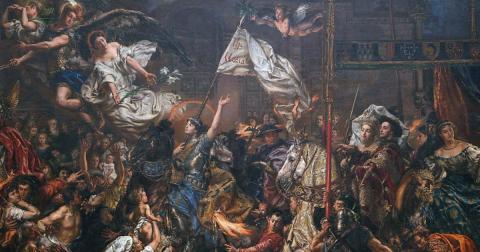Joan of Arc was a young peasant woman who lived during the last phase of the Hundred Years’ War. This war was a series of military conflicts between France and England which began in 1337 due to an inheritance dispute over the French throne. It ended in 1453. The 116 years of the war saw the rise and fall of several kings and nobles, many of whom are noteworthy in their own right. Joan of Arc, however, may be one of the most extraordinary figures from this period.
Though Joan is often perceived as a fearless warrior, she did not participate in active combat. Instead of a weapon, Joan held a banner and served as an inspiration to her troops while on the battlefield. Joan was also responsible for formulating military strategies, directing her troops, and engaging in diplomacy with the English.
After a victory at Orléans, Joan of Arc led the French to victory at Patay and Troyes, as well as liberating numerous French towns from the English. Then the way to Reims was open, and on the 17th of July 1429, Charles was crowned as the king of France at Reims.
Joan’s next target was the liberation of Paris, which also began in July, though it ended in failure in September of the same year. In May of 1430, Joan was captured by the Burgundians at Compiegne, and then sold to the English.
Joan of Arc was tried in the English stronghold of Rouen by an ecclesiastical court. Initially, there were 70 charges against her, which ranged from sorcery to horse theft. Eventually, these charges were reduced to just 12, including the wearing of men’s clothes and the claim that God had spoken to her directly. In exchange for an admission of guilt, Joan was offered life imprisonment.
She signed a document admitting her sins, though it has been speculated that since Joan was illiterate, she was not aware of what she was signing. Nevertheless, a few days later, Joan of Arc put on her male attire once again, possibly due to threats of rape or violence from her guards.
From transcripts of her trial, Joan seems lucid. Her judges asked her a trick question: whether she believed she was in a state of grace. If she said yes she would be claiming infallibility because no one can truly know the answer to this. If she said no she would undermine her claims to a divine calling. In a reply that thwarted their trickery, she stated: “If I am not, may God put me there; and if I am, may God so keep me. I should be the saddest creature in the world if I knew I were not in His grace.”
Discover more about Joan of Arc’s amazing story and a modern theory about why she heard ‘divine voices’ in the article ‘Speaking of Angels and Saints: The Story of Joan of Arc’ available in the January - February 2023 issue of Ancient Origins Magazine. Get it here!
Feature Image: Detail of ‘The Maid of Orléans’ (1886) by Jan Matejko. Source: Public domain
By Wu Mingren




